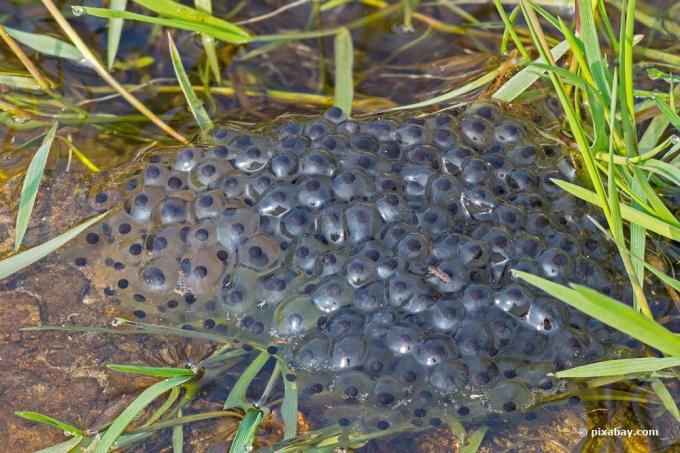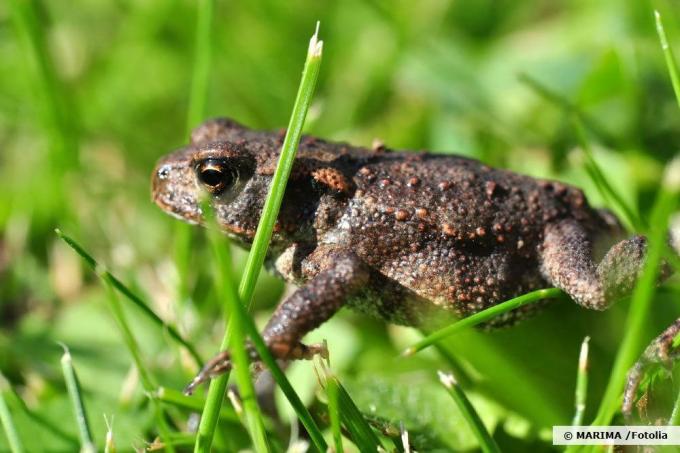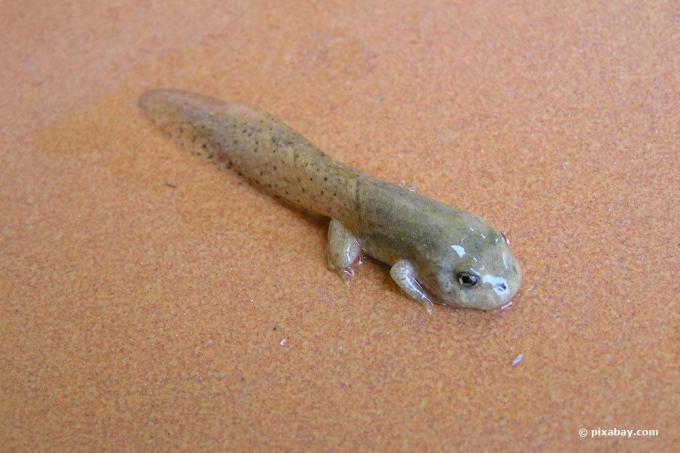
table of contents
- Frogs and toads
- Propagation time
- Matching search
- pairing
- Eggs and fertilization
- Spawning sites
- After oviposition / fertilization
- Mating frequency
- Egg development
- From the tadpole to the frog
- Young frog and toad
Frogs and toads are among the farm animals in the open countryside and in the home garden. For some they are unwelcome garden dwellers, for others they bring nature a little more into the home. Anyone who owns a garden pond or other stagnant body of water has a good chance of welcoming them one day. Water plays a major role in the reproduction and spawning of frogs and toads. Everything you need to know about it can be found here.
Frogs and toads
The green hoppers are often referred to as frogs or toads, although they are two different species. Both belong to the order of the frogs (Anura), but the toad species come from different families. In order to know which of the two species is present and when the spawning time is, they can be differentiated based on the following differences:
- Toads are more of a land animal and only move to the water to spawn - frogs love water
- Toads do not have webbed toes like frogs do
- The physique of toads is more plump than that of frogs
- Toads usually crawl / walk - frogs mostly jump
- Toads have almost the same length of front and rear legs - in frogs, the rear legs are significantly longer and slimmer
- Toad skin is wrinkled, leathery, often with wart-like or bump-like appearance - frog skin is usually smooth and often shiny
Propagation time
When frogs and toads reproduce depends on the species. Basically, early spring heralds the spawning season for the species that most frequently use the garden for spawning. These include:
- Agile frogs in late February
- Common frogs in early March
- Toad species between mid-March and early April
- Pond frog between late April and May
Note: A loud "croaking orchestra" is a clear sign of the upcoming mating season from early spring.
Matching search
Frogs and toads are loners, but the frog accepts conspecifics nearby and therefore does not go in any other direction. When the mating season arrives, it's time to find a female. Above all, more and more species of toads can be heard trying to attract females' attention with their attractant calls while Many a frog may already have one in its sights at its location, but its readiness through its mating calls proclaimed. These lure calls consist of loud croaking tones that can be heard within a radius of up to two kilometers. For maximum volume they use the so-called sound bubbles, as they are inflated laterally in the facial area. Some frog species make themselves noticeably quieter and croak under water.
pairing
If a pair of frogs has found each other to mate, this is done near the banks of the water or directly in the water. In most species, the males cling to the female axils. The toads hold on to the loins of the females for several days, but never for more than an hour at a time. In frogs and toads that spawn early, such as the common frogs, common frogs and the Common toads, the males already step their way to the spawning water on the back of the females "Piggyback" on.
Eggs and fertilization
It takes about a week for the females of the toads and frogs to spawn. To do this, they look for a suitable spawning site, where they usually lay their eggs in several successive phases. Some females move to another nearby place for the next egg-laying after each oviposition. Other species, such as green and brown frogs, on the other hand, lay their eggs all at once. It is only after spawning that the eggs are fertilized by the male's sperm, which he distributes over the eggs with his hind legs.
exception
Common midwife toad (Alytes obstetricans)
The reproduction / mating of the common midwife toad, which is seldom found in German gardens, takes place exclusively on land. Once the female has expelled the eggs there, the male lays them around his hind legs and leaves them there for several weeks until they are about to hatch. Only then are they released into the water as tadpoles.
Spawning sites
In principle, all frog and toad species lay their eggs on or in stagnant water. The toad stays on land and looks for a suitable place at the edge of the water, or from there pulls so-called spawning cords around plants or branches in the water. The natterjack toad is special because it lays its eggs on the bottom of the water.
The frog spawns right in the water. The frog eggs either adhere to aquatic plants or they float on the surface of the water as a compound ball. The latter can form large spawning carpets that can be up to several square meters in size.
tip: If you want to discover the small eggs, take a closer look, because then you will recognize jelly-like in the water Coats in which the eggs are located and which hold them together in such a way that balls and strings are formed can.
After oviposition / fertilization
When the female has finished laying her eggs, she usually leaves the scene after the male has released her grip. The female green frog is an exception and the males also remain at the spawning site. In some cases the “fathers” are still looking after the offspring, while others are already looking for the next females.
Mating frequency
It is not uncommon for males to mate four to five times. Most female toads only spawn every two years. Female frogs usually mate once a year. The natterjack toad is an exception several times a year. In addition to the frequency, the number of eggs is also interesting, as this varies greatly:
- Pond frogs: between 300 and 400 eggs per year
- Common toad: between 3,000 and 6,000 per year
- Golden toad: around 230 eggs per year
- Green toad: between 9,000 and 15,000 eggs per year
- Cane toad: between 8,000 and 25,000 eggs per year
Egg development
Already in the eggs the development of the larva begins. It only takes a few days for the first signs of a tadpole to appear. It takes more days for the jelly-like shell to dissolve and for the tiny tadpole to move freely in the water. When exactly this process is completed depends on the temperature and the species of frog / toad. This usually takes between five days and four weeks after the egg is laid. With the common frog it is usually after ten to 14 days.
The frog offspring can be recognized by the following characteristics and can be distinguished from toad tadpoles by these:
- Frog tadpoles are an average of two inches tall - toad tadpoles are only half the size
- Frog tadpoles have external gills
- The black underside of the toad offspring can be seen
- Frog offspring have eyes that are on the edge of their bodies
- Toad tadpoles mainly in shoals on the surface of the water

Chances of survival
The tadpoles' chances of survival are slim. It is estimated that at least three quarters of the offspring do not survive because they become victims of their natural predators. One of the most feared predators is the yellow beetle from the family of swimming beetles (Dytiscidae), which can eat up to 900 tadpoles a day. Other predators are:
- Newts
- Water bugs
- Dragonflies
- Water birds such as ducks and herons
tip: Should the predation of tadpoles in the garden pond are prevented, it is advisable to stretch a close-meshed net over it, which is a few centimeters away from the water surface. This is the only way to keep long-billed birds and insects out of the offspring.
From the tadpole to the frog
In order for the tadpoles to thrive, they initially feed on the jelly mass and later on algae and parts of plants. The first extremities appear after 1.5 to two months. The hind legs are visible first, while the front legs initially remain in "pockets" and only come out later. The further development takes place as follows:
- Two to three weeks later, shedding your rapeseed mouth (for previous food intake)
- Adjusting food intake
- Supply takes place exclusively through fat reserves
- Fat reserves come from the tail, which is now receding
- Forelegs appear
- Now has the stature / body shape of a young frog
- They go ashore after two to three days
- Body size: about one centimeter
- Adoption of sexual maturity: Depending on the weather and the type of frog, one to three years
Young frog and toad
In the case of the frogs, the young usually stay around the water / garden pond during the summer. Only when they have grown a little do they move into shallow water. The exception are common frogs, which, like the toad species, immediately set off for a suitable habitat after they exit the water as frogs and land animals. They only come back when sexual maturity has occurred and the cycle of reproduction begins again from the beginning.






